Looks like oscillation somewhere.
Yes. The output NPN transistors are suspect (see my previous post). The same amp with BD139/BD140 shows nothing like (again, see my previous post).These look like oscillations to me.
The problem is that at low Vce and high Ic, the DC current gain and the unity gain frequency of BJTs fall sharply - this effect is known as quasi-saturation. Unfortunately, it is rarely documented by manufacturers (Sanken is a happy exception).
As an illustration, here is the DC current gain of the 2SC5200 as a function of its collector current, measured at Vce= 4V and 5V:
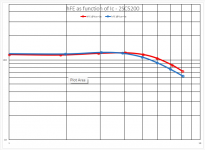
Here, a popular power transistor rated for 15 amps starts losing its beta above only 4 amps.
Quasi-saturation sometimes may be a problem in power amplifiers, but usually not in headphone amps. In particular, the BD139/BD140 pair chosen for Omicron behaves perfectly under a variety of loads, including those way beyond what Omicron was designed for. The SMT version runs on good old 2222/2907 with no issues.
The transistors used in baggerbole's build (2SC3421/2SA1358, both obsolete) should have the unity gain frequency of 120MHz, which is better than that for BD139/BD140. However, these particular specimens of 2SC3421 demonstrate very low current gain and what appears to be a poor frequency response. My suggestion is to replace them with the BD139/BD140, which are inexpensive, readily available, and have been demonstrated to work well.
Last edited:
I changed Q21/Q22 to BD139/BD140
Output is loaded with 2x16R
Yellow trace is output with 2SC3421/2SA1358
Blue trace is output with BD139/BD140
I´m pretty shure the 2SC3421 are genuine. I bought them many years ago from a reliable source.
Grounding the heatsink didn´t change the results.
It looks like your observations hit the nail
You did a great job Alex
Thank´s a lot for your patience with a dump guy. I have learned something.

Output is loaded with 2x16R
Yellow trace is output with 2SC3421/2SA1358
Blue trace is output with BD139/BD140
I´m pretty shure the 2SC3421 are genuine. I bought them many years ago from a reliable source.
Grounding the heatsink didn´t change the results.
It looks like your observations hit the nail
You did a great job Alex
Thank´s a lot for your patience with a dump guy. I have learned something.
Last edited:
Yay! I love it when a day starts with good news. Congratulations and thank you! 🎉🎇🎊Now change the transistors in the other channel and give Omicron a listen.
As for the 2SC3421, test them. With a regulated, current limited power supply, it's easy. Clamp (or bolt) the transistor to a heatsink and connect it as follows:

R1 protects the transistor against excessive base current (100mA max for 2SC3421). Vce is set to 5V because that's the voltage at which the datasheet specifies current gain:


Set Vce current limit to below 1A - that's the max collector current for 2SC3421. Set Vbe to zero and power it on. Now slowly increase Vbe and measure the base current Ib (e.g. as a voltage drop on R1) and the collector current Ic (directly with a DMM - the current limit at the power supply will protect both the transistor and the ammeter) at several Vbe values. Calculate hFE=Ic/Ib and compare it to the hFE-Ic chart from the datasheet. You can also vary Vce and compare the results to the Ic-Vce chart:

As for the 2SC3421, test them. With a regulated, current limited power supply, it's easy. Clamp (or bolt) the transistor to a heatsink and connect it as follows:
R1 protects the transistor against excessive base current (100mA max for 2SC3421). Vce is set to 5V because that's the voltage at which the datasheet specifies current gain:
Set Vce current limit to below 1A - that's the max collector current for 2SC3421. Set Vbe to zero and power it on. Now slowly increase Vbe and measure the base current Ib (e.g. as a voltage drop on R1) and the collector current Ic (directly with a DMM - the current limit at the power supply will protect both the transistor and the ammeter) at several Vbe values. Calculate hFE=Ic/Ib and compare it to the hFE-Ic chart from the datasheet. You can also vary Vce and compare the results to the Ic-Vce chart:
Both channels are BD139/BD140 now
Output is loaded with 2x16R
Yellow trace is output left
Blue trace is outputright
It sounds very good with the 16R planar headphones
But with the 30R in ears sound is hard, metalic and the voices are very thin and far away with an echo (hard to describe...)
Source was my smart phone with a good quad dac.
When I plug the in ears direct to the smart phone sound is very good too...
What´s this?

Output is loaded with 2x16R
Yellow trace is output left
Blue trace is outputright
It sounds very good with the 16R planar headphones
But with the 30R in ears sound is hard, metalic and the voices are very thin and far away with an echo (hard to describe...)
Source was my smart phone with a good quad dac.
When I plug the in ears direct to the smart phone sound is very good too...
What´s this?
I am curious, too. We tested with a variety of headphones with impedances from 32 to 600 ohm made by some popular manufacturers (Grado, Beyerdynamic, Sennheiser, AKG) and did not experience anything like. We did not extensively test with in-ears, as these tend to be designed for mobile use, which is not Omicron's intended use case. Yet, Apple's ubiquitous white wired EarPods do sound fantastic with Omicron, surprisingly so for a pair of small $20 earbuds.What´s this?
One things that comes to mind is the output impedance. In Omicron it is very, very low, basically the impedance of the output inductors, which is probably lower than the impedance of the earbuds's cord. My guess is that some headphones may be underdamped when driven by a low impedance source like Omicron, and e.g. their mechanical resonances can show up. Also, if the headphones have built-in crossovers (some IEMs are multi-way) or other frequency compensation, that compensation may be designed to expect a meaningful impedance from the driving source. (If you think a pair of earbuds is perfectly designed and cannot be improved, have a look at Linkwitz' page here.)
If you're willing to experiment, I'd suggest connecting small (1 to 10 ohm) resistors in series with Omicron's output, between Omicron and the cans, and see (or rather listen to) what happens.
On a different topic, did you decide to drop the power rail voltage to +/-12V? It occurred to me that in that case, you may want to reduce R11 R12 R31 R32 from 10k to 6.8k and adjust R13 R14 R33 R34 for the desired quiescent current. While this change is not critical, it would make a bit more current available to the bases of the output transistors, which should help when driving low impedance loads.
I´ll give the Omicron a serious burn in period and do more critical listening then.
I´m curious about the Whammy comparison
From my first impressions I think it would be a hard match for the Whammy...
I see no need to decrease the supply voltage. Omicron can drive my low sensitive headphones to painful volumes without effort. And the heat sink doesn't get too hot in the process.
I´m curious about the Whammy comparison
From my first impressions I think it would be a hard match for the Whammy...
I see no need to decrease the supply voltage. Omicron can drive my low sensitive headphones to painful volumes without effort. And the heat sink doesn't get too hot in the process.
Tested my Omicron today with a range of mobile earbuds and on-ear cans, ranging from the inexpensive Panasonic RP-TCM125 ($13 on Amazon) to the magnificent 3-way AKG K3003 IEMs (claimed to be "the best in-ear headphone ever made by far", with 8 ohm impedance):

The only problem found was not with Omicron or headphones but with a cheap 1/8" to 1/4" plug converter. As you can see in the picture, my copy of Omicron is equipped with a Neutrik 1/4" jack, so 1/8" plugs require an adapter. The one I had at hand worked with older no-mic earbuds, but more recent pairs equipped with a microphone sounded distorted, probably because of a poor common wire connection. Changing the adapter solved the problem, and each pair in the batch sounded as expected (within its budget).
I also got a chance to compare the sound with 200 ohm in series with the output (the SMT version of Omicron, pictured above, has a line output with RCR T-filters), which refuted my hypothesesis from #106 above. The low output impedance of Omicron is not a problem. Cheap plug converters are.
The only problem found was not with Omicron or headphones but with a cheap 1/8" to 1/4" plug converter. As you can see in the picture, my copy of Omicron is equipped with a Neutrik 1/4" jack, so 1/8" plugs require an adapter. The one I had at hand worked with older no-mic earbuds, but more recent pairs equipped with a microphone sounded distorted, probably because of a poor common wire connection. Changing the adapter solved the problem, and each pair in the batch sounded as expected (within its budget).
I also got a chance to compare the sound with 200 ohm in series with the output (the SMT version of Omicron, pictured above, has a line output with RCR T-filters), which refuted my hypothesesis from #106 above. The low output impedance of Omicron is not a problem. Cheap plug converters are.
Last edited:
Finally, tested the SMT board pictured in my previous post. The distortion performance is identical to that of the through-hole board with the same quiescent current (25mA) of the output stage.
BTW the output stage on this board is one pair of PZT222/PZT2907 in SOT-223 packages per channel with. With that quiescent current and +/-17V supply rails, the two channels dissipate 1.7W with no heatsink other than the PCB itself.
As long as the output stage stays in Class A, the distortion is hard to detect. Here is the THD and IMD when driving a 100 ohm load to 9Vpp (which is 200mW peak power or 100mW RMS on a sine)
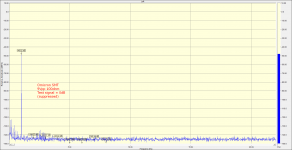
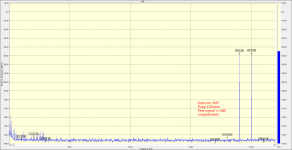
When driving a lower impedance loads to full power, the output stage leaves calls A, but Omicron still stays extremely linear:
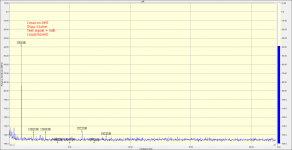
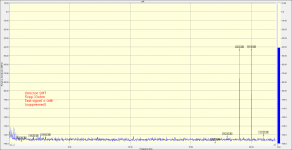
Compare these to the published distortion performance of other headamps claiming high or even ultra-high performance...
Clip is fine:
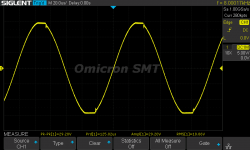
Response to a fast square wave has no surprises:
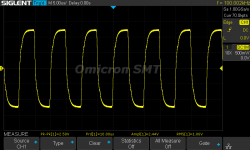
Using leakage inductance of a pulse transformer to isolate capacitive loads works fine. Many thanks to @Nazar_lv for the idea!
BTW the output stage on this board is one pair of PZT222/PZT2907 in SOT-223 packages per channel with. With that quiescent current and +/-17V supply rails, the two channels dissipate 1.7W with no heatsink other than the PCB itself.
As long as the output stage stays in Class A, the distortion is hard to detect. Here is the THD and IMD when driving a 100 ohm load to 9Vpp (which is 200mW peak power or 100mW RMS on a sine)


When driving a lower impedance loads to full power, the output stage leaves calls A, but Omicron still stays extremely linear:


Compare these to the published distortion performance of other headamps claiming high or even ultra-high performance...
Clip is fine:

Response to a fast square wave has no surprises:

Using leakage inductance of a pulse transformer to isolate capacitive loads works fine. Many thanks to @Nazar_lv for the idea!
Last edited:
One of the reasons for the development of the SMT version of Omicron was the wider variety of dual opamps in SOIC (vs PDIP). Below are the measurements of Omcron running on OPA1642. Its performance is just as great as that of NE5532:
THD 1kHz @ 5Vpp 33ohm:
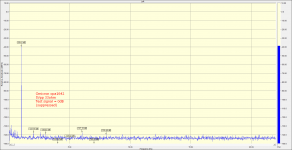
IMD 19+20kHz @ 5Vpp 33ohm:
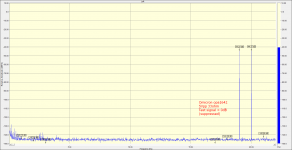
Clip @ 33ohm:
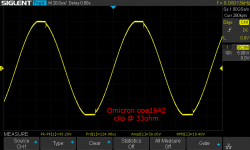
Fast square wave:
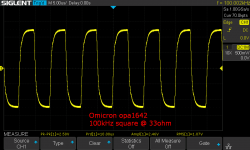
THD 1kHz @ 5Vpp 33ohm:

IMD 19+20kHz @ 5Vpp 33ohm:

Clip @ 33ohm:

Fast square wave:

After a few tries I found out that it is the output of my smart phone.I am curious, too. We tested with a variety of headphones with impedances from 32 to 600 ohm made by some popular manufacturers (Grado, Beyerdynamic, Sennheiser, AKG) and did not experience anything like. We did not extensively test with in-ears, as these tend to be designed for mobile use, which is not Omicron's intended use case. Yet, Apple's ubiquitous white wired EarPods do sound fantastic with Omicron, surprisingly so for a pair of small $20 earbuds.
One things that comes to mind is the output impedance. In Omicron it is very, very low, basically the impedance of the output inductors, which is probably lower than the impedance of the earbuds's cord. My guess is that some headphones may be underdamped when driven by a low impedance source like Omicron, and e.g. their mechanical resonances can show up. Also, if the headphones have built-in crossovers (some IEMs are multi-way) or other frequency compensation, that compensation may be designed to expect a meaningful impedance from the driving source. (If you think a pair of earbuds is perfectly designed and cannot be improved, have a look at Linkwitz' page here.)
If you're willing to experiment, I'd suggest connecting small (1 to 10 ohm) resistors in series with Omicron's output, between Omicron and the cans, and see (or rather listen to) what happens.
On a different topic, did you decide to drop the power rail voltage to +/-12V? It occurred to me that in that case, you may want to reduce R11 R12 R31 R32 from 10k to 6.8k and adjust R13 R14 R33 R34 for the desired quiescent current. While this change is not critical, it would make a bit more current available to the bases of the output transistors, which should help when driving low impedance loads.
It would see some load. After I connected both Omicron inputs with 100Ohm resistors in parallel, the sound was good for the cheap in ears. I don't have a real explanation for it though. Maybe you Alex?
After a 50+ hours burn in I gave the Omicron a more in deep listening session also in comparison to my Whammy.
Setup: ROON via Qobuz and highres files from SSD via LAN to quad stack DDDAC from Creative Audio. Headphones are Dan Clark Ether2 with 16Ohm impedance. This cans are not very sensitive...
Power supply for the Whammy with the internal power supply unit from the mains supply, Omicron with lithium accus +/- ~12V.
To make it short: For my aged ears it's a head to head race with a slight lead for Omicron.
Omicron shows a little more width and depth and little more precision and punch in bass.
Whammy tends a bit more to the warm side.
It´s not a real apple to apple comparison as the Whammy doesn´t have crossfeed and Omicron runs from battery....
Yes!, With laser eye surgery, Ear wax cleaning, air purifier, comfy bed, dating apps. etcAre you sure we're way better than our ancestors due to technology improvement? Do we see or hear better? Do we breathe better, do we sleep remarkably better, do we get laid more often?
Exception - We don't (always) think better, with each new advancements in technologies , we have devised better and more lethal ways to kill each other.. Our scientific accomplisments has surpassed our spiritual pursuit, we have guided missiles and misguided men
The phone's output likes to be loaded with lower impedance?with 100Ohm resistors in parallel
It should - compared to Omicron, my Whammy has two orders of magnitude (!) more harmonic distortion - of the "right" kind, of course - which does add some fairy dust🧚♀️ at the expense of clarity:Whammy tends a bit more to the warm side.
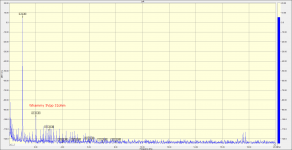
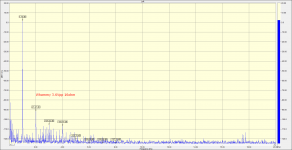
Thank you for sharing the experience!
Last edited:
Yes. Don´t ask me why...The phone's outputs likes to be loaded with lower impedance?
- Home
- Amplifiers
- Headphone Systems
- Omicron, a compact headphone amp with -140dB distortion
